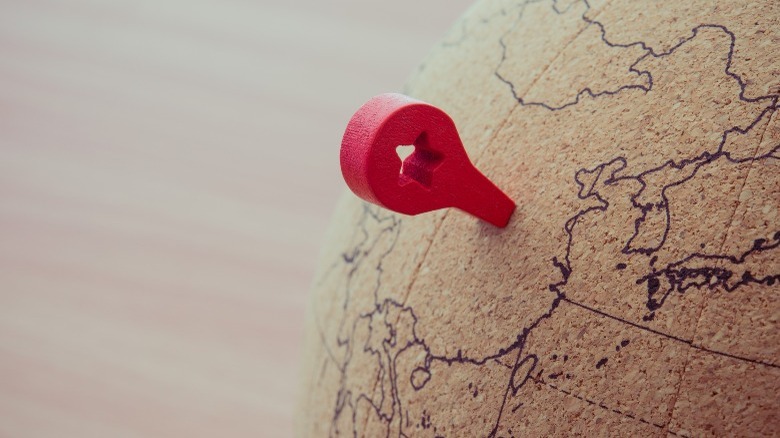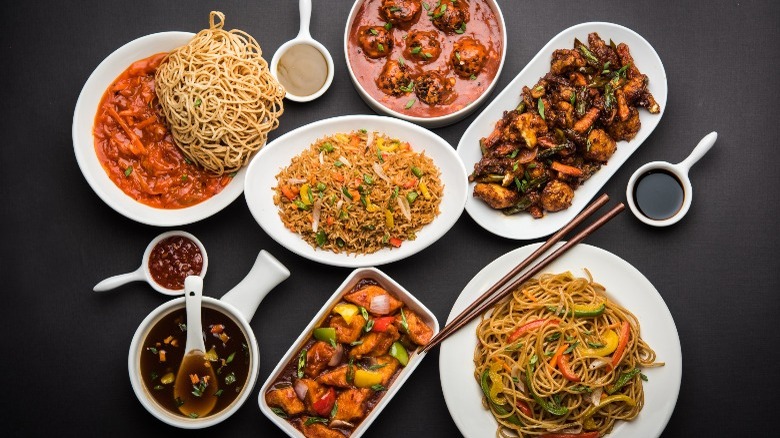The Untold Truth Of Chop Suey
Chop suey asks a lot of questions, or at least it makes the people eating it get very curious. Is it Chinese? Is it American? Where did it come from, and why has it disappeared from so many menus? It may look like an entirely different dish if you have it in a different restaurant.
There are a lot of answers to those questions, and sometimes they contradict each other. Chop suey has become the subject of hot debate, presidential recipes, and scholarly research. The deceptively-simple dish's story shines a light on racial prejudice, injustice, and questionable applications of Worcestershire sauce.
Whether you like it, love it, or have never tried it, the untold truth of chop suey is a fascinating ride. It has drama, connections to the red light district, and a confusing array of historical ingredients. If you're hungry for some history and a reason to get takeout tonight, you've come for the right tale.
The name means entrails and giblets
If you find yourself staring into a bowl of chop suey today, you'll probably recognize the meat. Although recipes vary, you'll likely have some simple chicken or beef tossed with vegetables. That was not always the case.
In the early days of chop suey, chefs embraced meats more popular in the day and less common in modern supermarkets: offal. There's been a lot of debate about the name of chop suey. A popular theory is that it grew out of the name for a Cantonese dish that roughly translates as "miscellaneous leftovers," according to Food & Wine. However, Atlas Obscura notes that according to historian Yu Renqui, "chop suey" probably comes from two Chinese characters that, together, refer to meat from organs and entrails.
In the 1800s, when chop suey first gained popularity with powerful (often white) Americans, it typically included a variety of ingredients like giblets and livers. Food critics of the day even noted them in their reviews. Today, those parts of animals get ground up into sausage and other processed meat products, but they added flavor and variety in the day before wide-spread refrigerators and freezers made it easy to transport butchered meat. It made sense to use everything an animal had to offer, and by accounts of the time, chop suey used organ meat very well.
Chop suey originated in the Pearl River Delta
Many stories claim to reveal the true origin of chop suey. Most are legends, and we'll probably never know who first made and sold chop suey in America. However, its reputation as an inauthentic Chinese dish that has lost most ties with the immigrants who first cooked it may be less true than many believe. While it may be a Chinese dish you won't find in China, it has some close cousins.
Scholar Nancy Yan suggests in Digest, that later Chinese immigrants, primarily from Guangzhou, wouldn't have recognized food from the Pearl River Delta, or Toishan region, which added fuel to the belief that chop suey wasn't really Chinese at all. In the 1800s, when chop suey became the poster dish for Chinese cuisine in America, Chinese immigrants primarily came from the Toishan region. In the mid-1900s, when another wave of immigrants arrived, they came from Guangzhou and the Yangzi River Valley. Yan also points out that her Chinese parents prepared chop suey and considered it a Chinese rather than Chinese-American dish.
It's a reminder of China's size and diversity. Consider how differently various cultures in Europe prepare food. Pasta and haggis are both European dishes, but people from Italy wouldn't recognize haggis as something that reminded them of home.
1800s chop suey had dragonfish (sometimes)
In 1886, a journalist named Allan Forman reviewed a dish of chop suey he enjoyed in New York. It had the expected variety of organ meats the dish was known for at the time, but he also mentioned a stranger ingredient: dried dragonfish imported from China (via Atlas Obscura). Words change with time, and it's challenging to know what kind of fish Forman referred to. He might not have known himself. As other items on this list demonstrate, journalists of the day played fast and loose with facts to make good headlines.
So what was in the chop suey? Today, we call a number of swimming creatures dragonfish or dragon fish. Sea moths — cute little fish with a big snout and wing-like fins — are sometimes called dragonfish. Deep sea dragonfish have no relation to the sea moths, glow in the dark, and look like they belong in a Tim Burton film.
Today, some types of Chinese cuisine still use a fish referred to as dragon fish, or Xia Chan. Chef William Wang even offers recipe tips for home chefs looking to make the most of the Xia Chan harvest season.
To complicate matters even more, some recipes today call specific dishes with seafood "Dragon Fish" due to spice, not species. So, what was in Mr. Forman's bowl? It's impossible to know for sure, but it was probably Xia Chan. There isn't much point in drying out and importing locally-available options.
A lawsuit made people believe chop suey was all-American
History Today notes that in 1904, a man named Lem Sen claimed he invented chop suey. It was a brainchild he birthed while working in a restaurant in San Francisco, he claimed, and it was stolen. Every Chinese eatery serving chop suey owed him money, he claimed. Even worse, according to History Today, Sen claimed the dish wasn't Chinese at all and was as American as "pork and beans."
Although Sen dropped his suit, and no one paid him for the honor of making a widely-known dish, the legend remained. Still, white Americans now had a ready excuse to explain their love of a dish made by people they passed legislation against. The 1882 Chinese Exclusion Act was the first of its kind, restricting immigration in new and dangerous ways.
Sen's lawsuit comforted a divided conscience for white Americans who enjoyed chop suey while supporting targeted immigration laws. If it was first made in America, then it was American, and that was that. To this day, the saying "as American as chop suey," persists about this pioneering dish of Chinese-American cuisine.
A Chinese diplomat gave chop suey celebrity status
In an effort to buoy up a strained political relationship between China and America, statesman Li Hongzhang came to visit New York in 1886. According to author Andrew Coe in an interview with Food Republic, White New Yorkers, in particular, were fascinated with him. The parade thrown in his honor wasn't enough to sate their curiosity. Newspapers capitalized on his visit with stories both real and imagined.
Once again, chop suey became the subject of legend. Nancy Yan reports three versions of the story in Digest. According to the first, the diplomat prepared chop suey for the Americans hosting him as part of a banquet. He purportedly designed it as a blend of Chinese technique and American ingredients. The second version of the story suggests he couldn't get used to American food and either ordered the cooks to prepare chop suey or went to New York's Chinatown to eat it at a restaurant. In the third version of the story, he tried it first in San Francisco and demanded cooks make something like it in New York. This last version was peddled by Lem Sen, who claimed he invented the dish specifically for the diplomat's visit as part of his claim to the recipe rights.
None of these stories are true. Most experts, including Coe and Yan, conclude that chop suey was just the only Chinese dish white journalists knew to reference, and that white readers would recognize as Chinese food.
Everyone ate canned chop suey
Canned foods have a mixed reputation. On the one hand, they keep food safe to eat and extend the shelf-life of everything from corn to spaghetti and meatballs. Unfortunately, there is another hand. For all of its practical benefits, canning changes a food's texture and flavor. Something you enjoy eating fresh may not be a meal you'd enjoy out of a can. You may love fresh green beans and hate the canned variety. That makes sense.
La Choy began canning and selling vegetables in sauce for buyers to make their own chop suey at home, according to the Association for Asian Studies, and by the 1930s their products were becoming commonplace across the U.S. Unfortunately, canned chop suey became so popular, it influenced the overall perception of the dish as a whole, and not for the better.
You can still buy canned chop suey vegetables and sauce from La Choy. If that isn't your thing, try asking your parents or grandparents if they ever tried it. Chances are, they have.
Chop suey was banned at the Mandarin
Once upon a time, chop suey was a dish for the rich. There are stories of it being served by celebrities and glitterati. It even appeared on the menu of the Victoria Hotel, one of Chicago's most exclusive venues at the time. However, appeals to a broader customer base seem to have made the dish less appealing to the foodies of the mid-1900s, according to Miranda Brown of Atlas Obscura.
It suffered a slow decline, and it always had its critics. However, by the 1960s it carried a cringe-culture image that conjured more haters than there were outspoken fans. While canning made it widely available, and it remained a popular take-out dish, it became so stigmatized in certain circles that Cecilia Chiang, the owner of the Mandarin, refused to serve it at all. Chiang's restaurant brought authentic, culturally-current Chinese dishes to Americans via a fine dining experience.
A refugee fleeing the devastation of WWII, Chiang represented a new wave of first-generation Chinese-Americans. Chop suey had been stewing in American kitchens for nearly 100 years, and it didn't taste like home. The fresh influences brought lots of exciting variety and change to Chinese cuisine in America, but it wasn't great news for chop suey, which suddenly looked like a dish that no one wanted to claim.
National Chop Suey Day is August 29th
If you want to make an occasion out of trying chop suey, there's no better day than August 29th. Why? It's National Chop Suey Day.
The dish isn't as common in Chinese restaurants as it used to be, but if you peruse the menus of your local restaurants, you may get lucky. If you live near a historic Chinatown, it's a great excuse to spend the day learning through food. You may find your new favorite eatery, because good chop suey must be a sign you're in a good Chinese restaurant.
If you like to keep things simple, August 29th is a good day to try the infamous La Choy canned chop suey mix. You get to choose which meat or meats to add, so you can make it your own. Enjoy cooking, but would rather skip the can? There are dozens of recipes for all kinds of chop suey online. All you have to do is pick the one that looks best to you. Whether or not your day includes chop suey is ultimately up to you, of course, but it couldn't hurt to try.
Chop suey houses faced a lot of backlash
It's hard to overstate how popular chop suey became and how big a role it played in the introduction of Chinese cuisine to the rest of America. It's fair to say the dish changed America forever. It was so essential to the American concept of what Chinese food looked like that many restaurants were simply called chop suey houses.
As popular as they were, Chinese eateries drew racist fear and hate that hardened into laws. These went beyond the various immigration bans and specifically targeted Chinese restaurants, or chop suey houses. According to the Chicago Tribune, one law in Massachusetts banned women from working or even entering such businesses. Similar laws appeared around the country.
Laws in 1906 heaped special fees and taxes on Chinese restaurants while others tried blocking restaurant licenses for anyone but American citizens. The Chicago Tribune points out that, at the time, Chinese residents could not become citizens. The Tribune notes the rationale for the blatantly racist, even for the time, rules and codes stemmed from the fact that many chop suey houses popped up around red light districts. They offered music and drinks into the later hours, and certain groups took this as an excuse to launch a pseudo-moral crusade.
Ultimately, the chop suey prevailed — even if it isn't as popular as it once was — and the Chinese restaurants that served it survived.
Chop suey recipes are open to interpretation
What even is chop suey? You can find it with brown sauce or a clear sauce. Sometimes it has meat, and sometimes it's all vegetables. According to professor Haiming Liu, the only two things all chop suey recipes have in common are that they're stir-fries and that they have some kind of sauce (via Smithsonian Magazine).
The term covers a pretty wide range of stir-fry dishes — then and now. It's no wonder people have to ask what the difference between chop suey and chow mein is. However, that isn't necessarily a bad thing. Since no one can entirely agree on what should or should not go in chop suey, it's easy to find a version you like.
As professor Liu points out, the original Chinese dish that inspired what Americans call chop suey looked different across the various regions in which it appeared. Because it has such a flexible definition, and it's built on the idea that everyone does it a little differently, chop suey is still evolving across recipe blogs across the internet.
Chop suey has inspired new American dishes
Like all great cultural dishes, chop suey inspired some spin-offs. Some of them spun farther away than others.
Although chop suey is generally regarded as a Chinese-American dish, regardless of authenticity or origin, American Chop Suey is another food entirely. American Chop Suey is a pasta-based casserole, according to Serious Eats, and its only connection to the chop suey of Chinese extraction is the name. "The Oxford Companion to American Food and Drink" describes the meal's origin in the Great Depression. The recipe evolved over time, calling for everything from barbeque sauce to macaroni and rice.
The New England Historical Society recounts tales of the Salem Chop Suey Sandwich, a dish still consumed along the East Coast. It has clearer inspiration in regards to its name. Between the buns, the sandwich contains meat, onions, celery, and bean sprouts in a thick sort of soy-based sauce.
All of this goes without mentioning the beauty of fusion foods, like this recipe shared by NPR from Joaquin Fajardo. His family's Mexican restaurant sat beside a Chinese restaurant, and when his family bought the Chinese eatery, creations like chop suey with beans and jalapenos appeared.
Presidents have enjoyed the dish
Despite signing the Immigration Act of 1924, one of President Calvin Coolidge's favorite foods was his wife's recipe for chop suey. She supposedly received the recipe from the Chinese chef of the presidential yacht when her term as First Lady concluded. A reprinting of the recipe from 1973 calls it "Frugal," which is a nice way of saying bland, if the ingredients are anything to go by. It notably includes a can of Chinese vegetables.
According to author Haiming Liu in the Journal of Transnational American Studies, President Eisenhower was not just a fan chop suey, but a regular at his favorite Chinese restaurant. He would go with his family to Sun Chop Suey Restaurant both before and during his presidency. Chicken chop suey was his favorite. Liu points out that the dish had gained an association with American rather than Chinese culture in the eyes of white American diners, which made it so easy to enjoy, regardless of what a statesman's views were outside the restaurant.
Chop suey appeared in the US Army cookbook
The 1942 Army cookbook didn't have many "ethnic" dishes. The handful listed included spaghetti. Chop suey also made the cut. The recipe was creative and left more than a little room for an individual cook's interpretation. It also suited the ever-changing availability of rations and supplies according to "The Oxford Companion to American Food and Drink."
Haiming Liu cites Harvey Levenstein concerning chop suey in the mess hall. The sauce was a combination of ketchup and Worcester sauce, and it wasn't a rare sight.
While soldiers were eating an inventive rendition of chop suey overseas, La Choy had to get creative in the States. According to Reference for Business, the government decided La Choy's Chinese and Asian products weren't necessities and took away the tin used for canning. The company survived using alternative packaging materials, and a lot of soldiers came home looking for chop suey, so the company grew.













